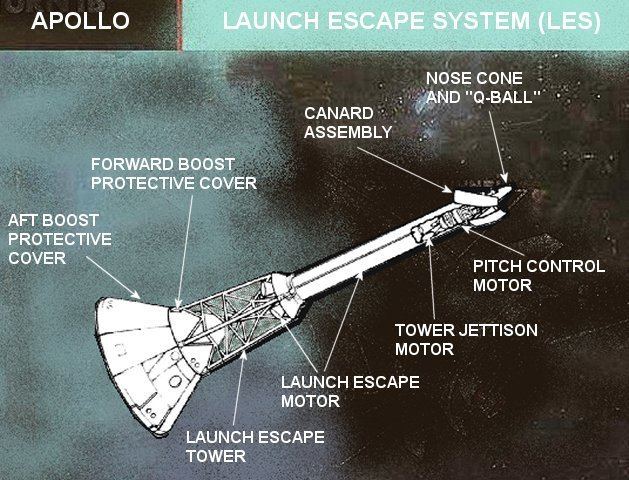During the launch of an Apollo spacecraft by the Saturn IB or Saturn V rocket, the flight could be aborted to rescue the crew if the rocket failed catastrophically. Depending on how far the flight had progressed, they would use different procedures or modes. None of these launch abort modes was ever used on any of the fifteen manned Apollo spacecraft flights.
Houston's announcements of the current abort mode and the spacecraft commander's acknowledgements were among the few things said on the radio link during the first minutes of flight.
If the rocket failed during the first phases of the flight, the Emergency Detection System (EDS) would automatically give the command to abort. The reason is that life-threatening situations can develop too fast for humans to discuss and react to. In the later, less violent phases of the ascent, the EDS was turned off and an abort would have to be initiated manually.
Of the five abort modes, the modes up to two (II) are variations of jettisoning the entire rocket followed by an immediate landing in the sea (splashdown). Mode three (III) and up are variations of jettisoning only the failing rocket stage, using the other stages to continue into Earth orbit. Once there, a backup Earth-orbit mission could be performed so that the flight was not entirely in vain. In all cases, the Command Module (CM) with the astronauts performs a splashdown by:
Dumping the hypergolic fuel overboard since the toxic substance would be an unnecessary risk to recovery personnel.If high enough, deploying high-speed parachutes (drogue parachute).Jettisoning the drogues and deploying the main parachutes.Splashing down in the sea and waiting for recovery team to arrive.Apollo's planned-for abort modes were, in chronological order:
Pad abort: If the rocket failed in the last five minutes before launch, the CM and the launch escape system (LES, see figure) would separate from the remainder of the rocket below with the LES propelling itself and the CM beneath it upward and eastward to the sea using a small solid-fueled motor (the launch escape motor) at the top of the tower on the launch escape system. The launch escape tower would then be jettisoned in anticipation of the parachute deployment and the CM would splash down. (Preparation for a pad abort is seen in Apollo video footage: five minutes before launch, the umbilical arm connecting to the CM retracts and swings clear of the rocket. It does so because the swing arm must be out of the way in case the EDS decides to abort.)Pad Abort Test-1: Launch Escape System (LES) abort test from launch pad with Apollo Boilerplate BP-6.Pad Abort Test-2: LES pad abort test of near Block-I CM with Apollo Boilerplate B-23A.Mode I: Abort using the LES, from launch until LES jettison 30 seconds after S-II ignition.Mode IA (one alpha): During the first 42 seconds of flight – up to 3,000 metres (9,800 ft) – the rocket is still relatively upright and an abort is much like a pad abort. The main and pitch control motors move the CM out of the flight path of the possibly exploding rocket. Fourteen seconds into the abort, the LES tower is jettisoned, leading to splashdown.Mode IB (one bravo): From 3,000 metres (9,800 ft) to 30.5 km (100,000 ft) (117 seconds after launch), the rocket is tilted eastwards far enough that firing the pitch control motor is unnecessary. After the LES main motor moved the CM away from the rocket, the tower would deploy canards (small wings at the tip). They would force the CM-LES combination to fly with the CM bottom forward (blunt-end forward or BEF attitude), necessary because the parachutes stowed at the CM top can only be deployed in a downwind direction.Mode IC (one charlie): From 30.5 km (100,000 ft, or about 19 miles) until the LES is jettisoned, turning the CM-LES combination around into the CM-forward position would still be necessary, but in the now thin air the canards are useless. Instead, the small engines of the CM's reaction control system (RCS) would do the job. During One-Charlie, the first staging occurs, that is the jettisoning of the spent first stage (S-IC) and ignition of the second stage (S-II). One-Charlie ceases about 30 seconds after the staging when the LES is jettisoned, at an altitude of about 90 km (295,000 ft or 55 miles).Mode II: Abort early during S-II burn. With the LES gone, the Command/Service Module (CSM) would separate as a whole from the rocket and use its large engine and RCS engines to move clear of the rocket and align itself. The CM would then separate from the SM and splash down.Mode III, also known as Contingency Orbit Insertion (COI) or S-IVB to COI: In case of an S-II failure, it would simply be jettisoned early. For the first time in the flight, the rocket is now high and fast enough that the third stage (S-IVB) engine, followed by the Service Module (SM) engine, has enough power to place the spacecraft in Earth orbit. The spent S-IVB would not have fuel to perform trans-lunar injection, so only an Earth-orbit mission would be performed.S-IVB to orbit: As in Mode III, the failing S-II would be jettisoned early, but Earth orbit insertion is now possible by the S-IVB alone. Other than not using the SM engine, this is identical to a Mode III abort. This abort mode ends with normal S-II jettison.Mode IV: Abort during S-IVB burn. Should the S-IVB fail, the Service Module engine can now place the CSM in Earth orbit to perform an Earth-orbit mission.The EDS is enabled for the pad abort (beginning 5 minutes prior to launch) through abort mode IB phases. Beginning in mode IC, the EDS is switched off and aborts must be commanded manually.

